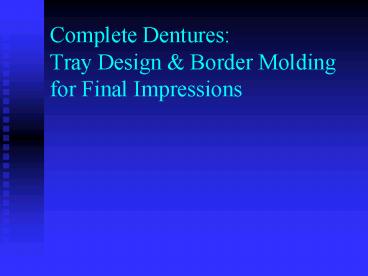Complete Dentures: Tray Design - PowerPoint PPT Presentation
1 / 42
Title: Complete Dentures: Tray Design
1
Complete DenturesTray Design Border Molding
for Final Impressions
2
Fabrication of Custom Trays
3
Why Use Custom Trays?
- Gordon J. Christensen, D.D.S., M.S.D., Ph.D-JADA,
May 1994 - Custom trays provide anatomically correct
extension of denture impressions. - Allow homogeneous thickness of impression
material. - Provide optimum accuracy and stability.
4
Economic Factors
- Stock trays require 3x to 4x the impression
material as custom trays. - At 14 cents to 45 cents/cc, the cost savings can
be 2 to more than 10 per full arch impression. - Reduced number of remakes due to distortion or
under-extension.
5
Identify Denture Extensions
- Mark the anticipated final extension of the
denture in red pencil on the cast
6
(No Transcript)
7
Mark Tray Extensions
- Mark the tray extension in blue pencil about two
mm shorter than red pencil line except - Coinciding with red line in hamular notch
- If you did not get a good transfer of your
posterior palatal seal, make the tray longer in
this area, mark in the mouth, and shorten to the
correct extension
8
(No Transcript)
9
Adapt Baseplate Wax to Blue Line on Cast
10
Tray Design
- A. Tray to extend to blue lines on casts.
- B. Lower handle no longer than the lower teeth
would be. - C. Upper handle approximately 20 mm to clear lip.
- D. Do not place vent holes at this time.
11
Adapting Tray Material
12
Handle Design
13
Cured Tray With Wax Inside
14
Trimming Tray
15
Completed Trays
16
Evaluating Trays
- Try tray in patients mouth tray should stay in
place passively when mouth is at rest - Remove any pressure areas/sharp spots
- Reduce any areas that cause the tray to lift when
lips, tongue, or cheeks are moved - Evaluate and correct posterior palatal seal
length of upper tray - Evaluate frenum areas
17
Pretty Good Rule 1
- You cannot make an over-extended tray shorter by
adding border molding compound.
18
Set-up for Border Molding
- Hot water bath
- Ice bath
- Hanau torch and bunsen burner
- Scalpel
- Indelible ink sticks
- Acrylic burs for slow speed handpiece
- 2 X 2 gauze
19
(No Transcript)
20
Border Molding
- Cut away pink wax in the segment you are border
molding - Heat green stick compound until soft, then stroke
it onto the tray - Flame with Hanau torch
- Temper in water bath
21
Border Molding
- Rotate tray into patients mouth
- Manipulate tissue to adapt green stick compound
to form final extensions of tray
22
(No Transcript)
23
(No Transcript)
24
(No Transcript)
25
(No Transcript)
26
(No Transcript)
27
(No Transcript)
28
(No Transcript)
29
(No Transcript)
30
(No Transcript)
31
(No Transcript)
32
(No Transcript)
33
(No Transcript)
34
(No Transcript)
35
Pretty Good Rule 2
- The tray is already wide enough, so most of the
green stick compound should go on the edges and
the inside of the tray.
36
Goals of Final Impressions
- 1.Maximum coverage of denture bearing areas-less
force/unit area less trauma - 2.Stabilization of dentures-bracing against
vertical portion of ridges - 3.Retention
- Adhesion by contact
- Border seal
37
Prepare Trays for Impression
- Remove slight amount of compound from every
surface, slightly more in frenum areas - Remove minimal amount from undercuts that will
still allow for tray seating - Remove remaining pink wax spacer
- Use round bur to place vent holes
- Coat tray and compound with adhesive
38
Impression Material
- Add enough light-bodied PVS to tray so it is
slightly thicker than the pink wax spacer that
you have removed - Use cement spatula to coat the tray evenly, as
well as over green compound borders - Rotate tray into mouth and seat to place
39
Impression
- Go through border molding movements, hold tray in
place until PVS is set - For mandibular impression, start with the lingual
movements, finishing with the posterior buccal
movements - Have patient close to a relaxed position while
mandibular impression sets
40
Verify Results
- Trim away excess PVS, re-seat impression in the
patients mouth - Evaluate stability, retention, patient comfort
- Re-mark vibrating line, if needed
- Box and pour impression
41
Trimmed Model
42
(No Transcript)































